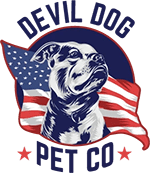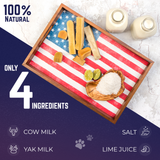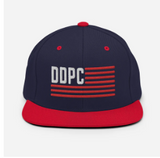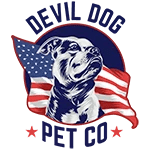Why Healthy Dog Treats Are Essential in 2025
Every dog owner faces the same challenge: finding treats that reward good behavior without compromising their pup's health. In 2025, the stakes are higher than ever. With rising veterinary costs and increasing awareness of diet-related health issues, the treats you choose today directly impact your dog's longevity, energy levels, and quality of life tomorrow.
Key Takeaways
- The top 10 healthy dog treats include single-ingredient options like freeze-dried liver, bully sticks, and elk antler chews.
- Functional treats with added benefits, such as dental chews and calming treats, are important for specific health needs.
- The best dog treats contain high-quality protein, natural ingredients, and no artificial additives.
- Choosing healthy treats helps support your dog's longevity, energy levels, and overall quality of life.
- In 2025, selecting the right treats is crucial due to rising veterinary costs and increased awareness of diet-related health issues.
Table of Contents
- Why Healthy Dog Treats Are Essential in 2025
- What Are Healthy Dog Treats?
- Key Nutritional Benefits of Healthy Dog Treats
- Types of Healthy Dog Treats
- How to Choose the Best Healthy Dog Treats: A Step-by-Step Guide
- How to Use Healthy Dog Treats Effectively
- Homemade vs. Store-Bought Healthy Dog Treats: Making the Right Choice
- Special Considerations: Age, Health, and Individual Needs
- Storage, Freshness, and Safety Protocols
- Conclusion: Building a Successful Healthy Treat Strategy
Here's what's changed: pet owners are demanding transparency. Gone are the days of grabbing any colorful bag off the shelf. Today's responsible dog owners read ingredient labels like nutritionists, research sourcing practices, and understand that healthy dog treats aren't just rewards—they're tools for building better dogs.
The market has responded. Premium treat manufacturers now prioritize single-ingredient formulas, traceable sourcing, and functional benefits that go beyond basic nutrition. Whether you're training a Lab puppy or managing a senior dog's dental health, the right treats can accelerate progress while supporting overall wellness.
But here's the challenge: with thousands of options flooding the market, how do you separate genuine quality from marketing hype? The answer lies in understanding what makes a treat truly healthy and matching those qualities to your dog's specific needs.
At Devil Dog Pet Co., we've seen this evolution firsthand. When we started sourcing premium chews for our dog Dexter, we couldn't find products that met our standards for quality, safety, and effectiveness. That experience taught us that the best dog treats for labs and other active breeds aren't just about flavor—they're about providing mental stimulation, supporting dental health, and delivering nutrition that complements a complete diet.
The science backs this up. Research consistently shows that dogs receiving high-quality treats as part of structured training programs demonstrate better behavioral outcomes, stronger human-animal bonds, and improved overall health markers compared to those given conventional treats or no treats at all.
What Are Healthy Dog Treats?

A healthy dog treat isn't just "not bad for your dog"—it actively contributes to their wellbeing. Healthy dog treats are defined by what they contain and, equally important, what they don't contain.
The foundation of any quality treat starts with high-quality protein. This means identifiable meat sources like "beef," "chicken," or "salmon"—not vague terms like "meat by-products" or "animal digest." The protein should be the primary ingredient, providing essential amino acids that support muscle maintenance, immune function, and energy production.
Natural ingredients form the second pillar. Healthy treats derive their flavor, texture, and nutritional value from recognizable whole foods. Think sweet potato, blueberries, or coconut oil—ingredients you'd find in your own kitchen. These natural components provide vitamins, minerals, and antioxidants that support everything from coat health to cognitive function.
Transparency matters more than ever. Premium treat manufacturers now provide detailed sourcing information, nutritional analyses, and clear explanations of their processing methods. This transparency allows you to make informed decisions based on your dog's specific needs and your values as an owner.
The absence of artificial additives distinguishes healthy treats from conventional options. No artificial colors, flavors, or preservatives means your dog gets nutrition without unnecessary chemicals. Many dogs with sensitivities or allergies show remarkable improvement when switched to clean, natural treats.
Healthy Treats
- Single or limited ingredient lists
- Named protein sources (beef, chicken, salmon)
- Natural preservation methods
- Functional benefits (dental, calming, joint support)
- Traceable sourcing information
- Appropriate calorie content
Conventional Treats
- Vague ingredient descriptions
- Artificial colors and flavors
- Chemical preservatives
- Filler ingredients (corn, wheat, soy)
- Unknown sourcing origins
- High calorie density without nutritional value
Functionality sets modern healthy treats apart from basic rewards. The best treats for labrador retrievers, for example, might include glucosamine for joint support, given the breed's predisposition to hip dysplasia. Calming treats with natural ingredients like chamomile or L-theanine help anxious dogs, while dental chews with specific textures and shapes actively clean teeth and freshen breath.
Size and calorie content matter more than most owners realize. Healthy treats are appropriately sized for training purposes—small enough to be consumed quickly without interrupting the learning process, yet substantial enough to motivate. The best treats for lab puppies are often smaller versions of adult formulas, accounting for developing digestive systems and smaller mouths.
Digestibility represents the final crucial factor. Healthy treats break down easily in your dog's system, providing nutrients without causing digestive upset. This is particularly important for dogs with sensitive stomachs or food allergies, where the wrong treat can trigger days of discomfort.
Key Nutritional Benefits of Healthy Dog Treats
Understanding the nutritional impact of treats transforms them from simple rewards into powerful tools for supporting your dog's health. When chosen correctly, treats contribute meaningful nutrition that complements your dog's complete diet while addressing specific health needs.
Protein content drives the primary benefit of quality treats. Unlike plant-based proteins, animal proteins provide complete amino acid profiles that support muscle maintenance, immune function, and energy production. For active breeds, this protein boost helps maintain lean muscle mass and supports recovery after exercise or training sessions.
The bioavailability of protein in treats matters significantly. Freeze-dried liver, for example, retains nearly all of its original protein content while becoming shelf-stable and intensely flavorful. This makes it an excellent choice for the best treats for labradors and other high-energy breeds that need readily available amino acids.
Vitamins and minerals in natural treats provide targeted health benefits. Organ meats like liver deliver vitamin A for eye health, B vitamins for energy metabolism, and iron for healthy blood. Sweet potato-based treats contribute beta-carotene and fiber, supporting immune function and digestive health.
Functional ingredients represent the cutting edge of healthy treat development. Glucosamine and chondroitin support joint health—particularly valuable for large breeds prone to hip and elbow dysplasia. Omega-3 fatty acids from fish-based treats promote healthy skin and coat while supporting cognitive function in senior dogs.
Probiotics in treats support digestive health by maintaining beneficial gut bacteria. This is especially important for dogs with sensitive stomachs or those recovering from antibiotic treatment. The best puppy treats for labs often include probiotics to support developing digestive systems.
Dental health benefits from appropriately textured treats cannot be overstated. Chewing action stimulates saliva production, which naturally cleanses the mouth and neutralizes harmful bacteria. Hard chews like antlers provide mechanical cleaning action, scraping plaque from teeth surfaces during extended chewing sessions.
Weight management becomes easier with properly portioned, nutrient-dense treats. High-quality treats deliver more satisfaction per calorie, allowing you to reward your dog effectively while maintaining proper body condition. This is crucial for breeds prone to weight gain, where excess pounds can exacerbate joint problems and reduce lifespan.
The mental stimulation provided by long-lasting chews offers psychological benefits that extend beyond nutrition. Extended chewing releases endorphins, reducing stress and anxiety while providing constructive outlet for natural chewing instincts. This mental engagement is particularly valuable for intelligent breeds that need cognitive challenges to prevent destructive behaviors.
Hydration support comes from treats with higher moisture content, particularly beneficial for dogs who don't drink enough water. Frozen treats made from bone broth or pureed fruits provide both nutrition and hydration, especially valuable during hot weather or for senior dogs with reduced thirst drive.
Types of Healthy Dog Treats

Understanding the different categories of healthy treats helps you match the right option to your dog's specific needs, age, and preferences. Each type serves distinct purposes and offers unique benefits that go beyond basic reward functionality.
Soft & Chewy Treats - Training Excellence
Soft treats represent the gold standard for training sessions. Their pliable texture allows for quick consumption without interrupting the learning flow, making them ideal for rapid-fire reward sequences. The best treats for labrador puppy training often fall into this category because young dogs can easily chew and swallow them without choking risk.
These treats typically contain higher moisture content, which intensifies flavor and aroma—crucial factors for maintaining your dog's attention during training. Premium soft treats use natural binding agents like sweet potato or tapioca instead of artificial gums, providing clean nutrition alongside convenience.
Crunchy & Baked Treats - Dental Support
Hard, crunchy treats provide mechanical cleaning action that supports dental health. The abrasive texture helps scrape plaque from tooth surfaces while the chewing action stimulates saliva production, naturally cleansing the mouth. These treats work particularly well for the best treats for labs and other breeds with strong jaws.
Quality baked treats use whole grain flours or grain-free alternatives like chickpea flour, providing complex carbohydrates and fiber. The baking process creates a satisfying crunch that many dogs find irresistible while extending the eating experience compared to soft alternatives.
Freeze-Dried & Single-Ingredient Treats - Pure Nutrition
Freeze-dried treats preserve maximum nutritional value while creating shelf-stable products with intense flavor concentration. Single-ingredient options like freeze-dried liver or salmon provide pure protein without fillers, making them excellent choices for dogs with food sensitivities or allergies.
The freeze-drying process removes moisture while maintaining the cellular structure of the original ingredient, resulting in treats that rehydrate in your dog's mouth and deliver concentrated flavor. These treats often serve as high-value rewards for challenging training scenarios.
Functional & Specialty Treats - Targeted Health Benefits
Modern functional treats address specific health concerns through carefully selected ingredients. Calming treats incorporate natural relaxants like chamomile or L-theanine, while joint support treats include glucosamine and chondroitin. Dental chews feature specific shapes and textures designed to clean teeth and freshen breath.
These treats represent the evolution of pet nutrition from basic rewards to targeted health interventions. The best treats for labradors might include hip and joint support formulas, given the breed's predisposition to orthopedic issues.
Long-Lasting Chews
- Provide extended mental stimulation
- Support dental health through mechanical cleaning
- Reduce destructive chewing behaviors
- Offer excellent value per chewing hour
- Help manage anxiety and stress
Considerations
- Require supervision to prevent choking
- May be too hard for senior dogs
- Can vary in quality and safety
- Not suitable for quick training rewards
- Need proper sizing for safety
How to Choose the Best Healthy Dog Treats: A Step-by-Step Guide
Selecting the right treats requires a systematic approach that considers your dog's individual needs, health status, and training goals. This process transforms treat selection from guesswork into strategic nutrition planning.
Step 1: Master Ingredient Label Reading
Start with the ingredient list, where items appear in descending order by weight. The first ingredient should be a named protein source—"chicken," "beef," or "salmon"—not vague terms like "meat meal" or "poultry by-product." Quality treats typically feature 3-8 ingredients, with each serving a specific nutritional purpose.
Avoid treats containing artificial colors (Red 40, Yellow 5), chemical preservatives (BHA, BHT, ethoxyquin), and excessive fillers like corn syrup or wheat gluten. Natural preservatives like mixed tocopherols (vitamin E) or rosemary extract indicate higher quality manufacturing standards.
Step 2: Verify Certifications and Standards
Look for meaningful certifications that indicate third-party verification of quality claims. USDA Organic certification ensures ingredients meet strict organic standards, while Non-GMO Project verification confirms genetic modification absence. For dental treats, VOHC (Veterinary Oral Health Council) approval indicates proven plaque and tartar reduction benefits.
Manufacturing standards matter equally. Treats produced in USDA-inspected facilities or those following human food safety protocols typically offer superior quality control compared to facilities with minimal oversight.
Step 3: Match Treats to Your Dog's Specific Profile
Consider your dog's life stage, size, and activity level when selecting treats. Puppies need softer textures and smaller sizes, while senior dogs benefit from easily digestible options that don't stress aging teeth. The best puppy treats for labs differ significantly from optimal choices for adult or senior dogs of the same breed.
Activity level influences treat selection significantly. High-energy dogs benefit from protein-rich options that support muscle recovery, while less active dogs need lower-calorie treats to prevent weight gain. Working dogs or those in intensive training may require higher-value treats to maintain motivation.
Step 4: Address Allergies and Sensitivities
Food allergies and sensitivities require careful treat selection to avoid triggering reactions. Common allergens include beef, chicken, dairy, wheat, and soy. Limited ingredient treats or novel protein sources like venison, duck, or fish often work well for sensitive dogs.
Introduce new treats gradually, offering small amounts while monitoring for adverse reactions like digestive upset, skin irritation, or behavioral changes. Keep a food diary to track which treats your dog tolerates well and which cause problems.
Step 5: Calculate Calorie Content and Portion Control
Treats should comprise no more than 10% of your dog's daily caloric intake to maintain nutritional balance. A 50-pound dog requiring 1,200 calories daily should receive no more than 120 calories from treats. This calculation helps prevent weight gain while ensuring adequate nutrition from their complete diet.
High-value treats often contain more calories per piece, requiring smaller portions or reduced meal sizes to compensate. The best treats for labrador training sessions might be broken into smaller pieces to extend training time without exceeding calorie limits.
Step 6: Align Treats with Specific Purposes
Different training scenarios require different treat characteristics. Basic obedience training works well with soft, quickly consumed treats, while recall training might require higher-value options like freeze-dried liver. Enrichment activities benefit from long-lasting chews that provide extended mental stimulation.
Behavioral modification often requires premium treats that your dog finds irresistible. These high-value options help override distractions and maintain focus during challenging training scenarios. The investment in quality treats often accelerates training progress, saving time and frustration.
How to Use Healthy Dog Treats Effectively

The strategic use of treats transforms them from simple rewards into powerful tools for shaping behavior, building relationships, and supporting your dog's overall wellbeing. Proper implementation maximizes benefits while preventing common pitfalls that can undermine training progress or health.
Training Optimization Techniques
Effective training requires treating at the precise moment your dog exhibits desired behavior. This timing, called "marking," creates clear associations between actions and rewards. High-value treats work best for new behaviors or challenging training scenarios, while lower-value options suffice for well-established commands.
Treat size directly impacts training efficiency. Pieces should be small enough for quick consumption—typically pea-sized for medium dogs—preventing interruptions in the learning flow. The best treats for labrador training sessions can often be broken into 4-6 pieces, extending training time while controlling calorie intake.
Vary treat types to maintain interest and motivation. Rotating between different flavors and textures prevents habituation, where dogs become less responsive to familiar rewards. This variety also helps identify which treats your dog finds most motivating for different training contexts.
Building Habits Through Positive Reinforcement
Consistent treat delivery strengthens desired behaviors while creating positive associations with training sessions. The key lies in rewarding effort and progress, not just perfect performance. This approach builds confidence and enthusiasm for learning new skills.
Jackpot rewards—giving multiple treats for exceptional performance—create memorable experiences that accelerate learning. Use this technique sparingly for breakthrough moments or particularly challenging accomplishments to maximize impact.
Enrichment and Mental Stimulation Applications
Long-lasting chews provide crucial mental stimulation that prevents boredom-related behavioral problems. These treats engage your dog's natural chewing instincts constructively while providing extended entertainment. The mental focus required for sustained chewing releases calming endorphins that reduce stress and anxiety.
Puzzle treats and interactive dispensers transform treat time into problem-solving exercises. These tools slow consumption while engaging cognitive abilities, making treat time more satisfying and mentally enriching. This approach particularly benefits intelligent breeds that need mental challenges to thrive.
Safe Introduction Protocols
Introduce new treats gradually to monitor for adverse reactions and allow digestive adjustment. Start with small portions while observing for signs of digestive upset, allergic reactions, or behavioral changes. This cautious approach prevents problems while identifying treats that work well for your dog.
Transition periods help dogs adjust to new flavors and textures without overwhelming their systems. The best treats for labrador puppy introduction might involve mixing small amounts of new treats with familiar favorites, gradually increasing the proportion over several days.
Keep detailed records of treat introductions, noting which options your dog enjoys and tolerates well. This information proves invaluable for future treat selection and helps identify patterns if problems arise.
Balancing Treats with Main Meals
Adjust meal portions to account for treat calories, maintaining overall caloric balance. Dogs receiving substantial treats during training sessions may need reduced meal sizes to prevent weight gain. This balance ensures treats enhance rather than compromise nutritional status.
Time treat distribution throughout the day to support training goals while maintaining appetite for regular meals. Avoid giving treats immediately before meals, which can reduce interest in balanced nutrition. Strategic timing maximizes both training effectiveness and nutritional benefits.
Monitor body condition regularly to ensure treat integration doesn't lead to weight gain. Monthly weight checks and body condition scoring help identify problems early, allowing for quick adjustments to treat quantities or meal sizes.
Homemade vs. Store-Bought Healthy Dog Treats: Making the Right Choice
The decision between homemade and commercial treats involves weighing control, convenience, and cost factors against your lifestyle and dog's specific needs. Both approaches offer distinct advantages when executed properly, but success depends on understanding the trade-offs involved.
Homemade Treats: Complete Control with Commitment
Creating treats at home provides absolute ingredient control and customization opportunities. You select every component, ensuring quality standards and avoiding problematic additives. This approach works particularly well for dogs with multiple allergies or sensitivities, where commercial options prove limited or expensive.
Homemade treats often cost less per serving than premium commercial alternatives, especially when buying ingredients in bulk. Simple recipes using sweet potato, pumpkin, or lean meats create nutritious options without complex preparation. The best treats for labrador puppy development might include homemade frozen treats that soothe teething discomfort while providing nutrition.
Homemade Advantages
- Complete ingredient control and transparency
- Customization for specific dietary needs
- Cost-effective for large quantities
- Fresh preparation without preservatives
- Ability to adjust texture and size precisely
Homemade Challenges
- Time-intensive preparation and cleanup
- Limited shelf life requiring frequent batches
- Nutritional balance requires careful planning
- Inconsistent results during learning phase
- Storage and food safety considerations
Commercial Treats: Professional Formulation and Convenience
Quality commercial treats offer professional formulation, consistent nutrition, and convenience that busy owners appreciate. Reputable manufacturers invest in research, testing, and quality control systems that home kitchens cannot replicate. These treats undergo safety testing and nutritional analysis that ensures consistent results.
Commercial options provide variety and specialized formulations addressing specific health concerns. Dental chews, joint support treats, and calming formulas require expertise and specialized ingredients that make home preparation impractical. The best treats for labradors with hip concerns might include glucosamine-enhanced commercial options that would be difficult to formulate at home.
The Hybrid Approach: Combining Both Strategies
Many successful dog owners combine homemade and commercial treats strategically. Simple homemade options like frozen Kong stuffing or dehydrated sweet potato complement commercial training treats and specialized chews. This approach maximizes benefits while minimizing individual drawbacks.
Use homemade treats for daily enrichment and basic training, while relying on commercial options for specialized needs like dental health or behavioral modification. This strategy provides variety while ensuring nutritional adequacy and convenience when time is limited.
Special Considerations: Age, Health, and Individual Needs
Different life stages and health conditions require tailored treat selection approaches. Understanding these specific needs ensures treats support rather than compromise your dog's wellbeing throughout their lifetime.
Puppy-Specific Requirements and Development Support
Puppies need treats that support rapid growth while accommodating developing teeth and digestive systems. Soft textures prevent dental damage during teething phases, while appropriate sizing prevents choking hazards. The best puppy treats for labs should be easily digestible and sized for safe consumption by growing mouths.
Calcium and phosphorus ratios in puppy treats must complement their main diet to prevent developmental orthopedic diseases. Excessive calcium from treats can interfere with proper bone development, making ingredient awareness crucial during this critical growth period.
Training intensity increases during puppyhood, requiring treats that maintain motivation without causing digestive upset. Frequent treat consumption during house training and basic obedience requires easily digestible options that won't disrupt elimination schedules.
Senior Dog Adaptations and Comfort Considerations
Aging dogs often require softer treats that accommodate dental wear and reduced chewing strength. Digestive changes may necessitate easily processed options with minimal ingredients. Senior-specific formulations might include joint support compounds or cognitive health ingredients like omega-3 fatty acids.
Calorie requirements typically decrease with age and activity reduction, making lower-calorie treats important for weight management. The best treats for labradors entering their senior years should support joint health while providing mental stimulation without excessive calories.
Medication interactions become more relevant as dogs age, requiring careful ingredient selection. Some natural treat ingredients can affect drug absorption or metabolism, making veterinary consultation important when introducing new treats to senior dogs.
Allergy Management and Elimination Strategies
Food allergies require systematic treat selection using novel proteins or limited ingredient formulations. Successful management often involves identifying safe ingredients through elimination trials, then building a treat rotation around those components.
Environmental allergies may worsen with certain treat ingredients, requiring careful observation of symptom patterns. Dogs with seasonal allergies might benefit from treats containing natural antihistamines or omega-3 fatty acids that support skin health.
Cross-contamination concerns make manufacturing facility information important for severely allergic dogs. Treats produced in dedicated facilities without problematic ingredients provide additional safety margins for sensitive individuals.
Weight Management and Metabolic Health
Overweight dogs require careful treat selection that maintains training effectiveness while supporting weight loss goals. Low-calorie, high-protein options provide satiety without excessive energy intake. Portion control becomes even more critical when managing weight through diet modification.
Metabolic conditions like diabetes require treats with minimal carbohydrate content and predictable effects on blood glucose. Consistent treat timing and composition help maintain stable glucose levels while supporting training and enrichment needs.
Weight management success often depends on finding satisfying treats that don't trigger food-seeking behaviors. High-protein, high-fiber options provide satiety signals that help dogs feel satisfied with smaller portions.
Storage, Freshness, and Safety Protocols
Proper storage extends treat life while maintaining nutritional value and safety. Understanding storage requirements prevents waste while ensuring your dog receives maximum benefit from quality treats.
Optimal Storage Conditions by Treat Type
Dry treats require cool, dry storage away from direct sunlight and temperature fluctuations. Airtight containers prevent moisture absorption and pest contamination while maintaining freshness. Most commercial dry treats maintain quality for 12-18 months when stored properly.
Soft treats typically require refrigeration after opening, with shorter shelf lives than dry alternatives. Freeze portions for longer storage, thawing only what you'll use within a few days. The best treats for labrador training sessions might be portioned and frozen in daily amounts for convenience.
Homemade treats generally have shorter shelf lives due to lack of preservatives. Refrigerate for up to one week or freeze for up to three months, using proper packaging to prevent freezer burn and maintain texture.
Safety Monitoring and Quality Assessment
Regular treat inspection prevents feeding spoiled or contaminated products. Check for mold, unusual odors, texture changes, or pest contamination before each use. Discard any treats showing signs of deterioration, regardless of expiration dates.
Temperature abuse during shipping or storage can compromise treat safety even before expiration dates. Be particularly cautious with treats exposed to extreme temperatures or moisture, which can accelerate spoilage processes.
Batch tracking helps identify potential quality issues and facilitates recalls when necessary. Keep packaging with lot numbers and expiration dates until treats are consumed, allowing for quick identification if problems arise.
Conclusion: Building a Successful Healthy Treat Strategy
The journey to finding the perfect healthy treats for your dog requires patience, observation, and strategic thinking. Success comes from understanding your dog's individual needs, preferences, and health requirements while maintaining realistic expectations about what treats can and cannot accomplish.
Quality treats serve as tools for training, enrichment, and bonding, but they cannot replace proper nutrition, exercise, and veterinary care. The top 10 healthy dog treats for your specific dog might differ significantly from general recommendations, emphasizing the importance of individualized selection based on your dog's unique profile.
Start with small quantities of new treats, observe your dog's responses, and build a rotation of proven options that support your training goals and lifestyle. Remember that the best treat is one that your dog enjoys, tolerates well, and helps you achieve your relationship and training objectives.
Investment in quality treats pays dividends through improved training success, better dental health, and enhanced mental stimulation. As you develop expertise in treat selection and usage, you'll find that these small decisions contribute significantly to your dog's overall wellbeing and your satisfaction as a responsible owner.
The world of healthy dog treats continues evolving with new research, ingredients, and manufacturing techniques. Stay informed about developments while maintaining focus on proven principles: quality ingredients, appropriate sizing, proper storage, and strategic usage that supports your dog's health and happiness throughout their lifetime. For further reading, see this expert guide to the best dog treats and natural treats for dogs from veterinary professionals.
Download the FREE 10-Step Dog Prep Guide
Frequently Asked Questions
What is the healthiest treat to give a dog?
The healthiest treats are those made from single, natural ingredients that support your dog’s nutritional needs without fillers, artificial additives, or excess calories. Think air-dried meats, limited-ingredient chews like antlers or yak chews, and fresh fruits or veggies that are safe for dogs. These treats promote dental health, provide mental enrichment, and align with your dog’s dietary needs—especially when portioned properly.
What brand of dog treats are healthy?
Healthy dog treats come from brands committed to transparency, ethical sourcing, and minimal processing. Look for companies that prioritize single-ingredient or limited-ingredient recipes, avoid artificial preservatives, and use human-grade sourcing standards. The best brands back their products with quality control and provide clear nutrition information so you can match treats to your dog’s specific needs and health goals.
Are greenies for dogs safe?
Greenies can be safe when given in appropriate sizes and supervised, but they are processed dental treats that some dogs may chew too aggressively, risking dental fractures or choking. They contain ingredients aimed at plaque control but aren’t natural chews. If you choose to use them, monitor chewing habits carefully and consider pairing with natural options that promote slow, focused chewing and jaw exercise.
What is the best treat for dogs on a diet?
For dogs on a diet, low-calorie, nutrient-dense treats like dehydrated meat strips, single-ingredient chews, or small pieces of safe fruits and vegetables are best. These satisfy hunger and reward good behavior without tipping daily calorie intake. Always factor treats into your dog’s overall meal plan, keeping total treat calories under 10% to maintain healthy weight management.
What dog treats do vets recommend?
Vets recommend treats that support dental health, are easily digestible, and free from harmful additives or allergens. Single-protein, limited-ingredient chews such as yak chews, bully sticks, or natural antlers often top this list. They also encourage treats that offer mental stimulation and promote healthy chewing habits to reduce destructive behaviors and maintain oral hygiene.
Are pig ears safe for dogs?
Pig ears can be safe for some dogs but carry risks including bacterial contamination, choking hazards, and digestive upset—especially if your dog is a power chewer. They are fatty and calorie-dense, which can contribute to weight gain and pancreatitis in sensitive dogs. If you opt for pig ears, buy from reputable sources, supervise chewing, and limit frequency to reduce health risks.






